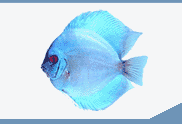

 |
||||||||||||
 |
||||||||||||
| Introduction to Freshwater Fish Parasites | ||||||
| Page 9 of 14 | Pages: 1 . 2 . 3 . 4 . 5 . 6 . 7 . 8 . 9 . 10 . 11 . 12 . 13 . 14 | |||||
MONOGENEAN TREMATODES Monogenean trematodes, also called flatworms or flukes, commonly invade the gills, skin, and fins of fish. Monogeneans have a direct life cycle (no intermediate host) and are host- and site-specific. In fact, some adults will remain permanently attached to a single site on the host. Freshwater fish infested with skin-inhabiting flukes become lethargic, swim near the surface, seek the sides of the pool or pond, and their appetite dwindles. They may be seen rubbing the bottom or sides of the holding facility (flashing). The skin where the flukes are attached shows areas of scale loss and may ooze a pinkish fluid. Gills may be swollen and pale, respiration rate may be increased, and fish will be less tolerant of low oxygen conditions. "Piping", gulping air at the water surface, may be observed in severe respiratory distress. Large numbers (>10 organisms per low power field) of monogeneans on either the skin or gills may result in significant damage and mortality. Secondary infection by bacteria and fungus is common on tissue with monogenean damage. Gyrodactylus and Dactylogyrus are the two most common genera of monogeneans that infect freshwater fish ( Figure 17 ). They differ in their reproductive strategies and their method of attachment to the host fish. Gyrodactylus have no eyespots, two pairs of anchor hooks, and are generally found on the skin and fins of fish. They are live bearers (viviparous) in which the adult parasite can be seen with a fully developed embryo inside the adult's reproductive tract. This reproductive strategy allows populations of Gyrodactylus to multiply quickly, particularly in closed systems where water exchange is minimal.  Figure 17: An illustration of a Gyrodactylus and Dactylogyrus.
Figure 17: An illustration of a Gyrodactylus and Dactylogyrus.
Dactylogyrus prefers to attach to gills. They have two to four eyespots, one pair of large anchor hooks, and are egg layers. The eggs hatch into free-swimming larvae and are carried to a new host by water currents and their own ciliated movement. The eggs can be resilient to chemical treatment, and multiple applications of a treatment are usually recommended to control this group of organisms. Treatment of monogeneans trematodes Treatment of monogeneans is usually not satisfactory unless the primary cause of increased fluke infestations is found and alleviated. The treatment of choice for freshwater fish is formalin, administered as a short-term or prolonged bath ( Table 1 ). Fish that are sick do not tolerate formalin well, so they need to be carefully monitored during treatment. Potassium permanganate can also be effective in controlling monogeneans. For more information, see IFAS Fact Sheet FA-28 , Monogenean Trematodes . more ... |
 |
|||||
| About Us :: Message Board :: Chat | |||||
| Library :: Photo Gallery :: Links & Resources :: Breeders & Sponsors :: Merchandise | |||||
| Website designed by: EthanCote.com | � 2001-2004, SimplyDiscus.com. All Rights Reserved. | ||||